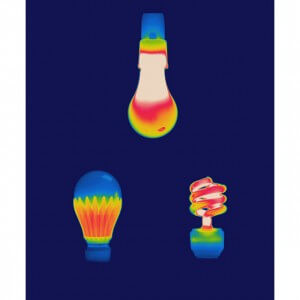
Do LED Lights Produce Heat?
By Joshua Prieto – 11/05/15
Short Answer:
LED lights produce a small amount of heat. LED lights do not use heat to create light, unlike traditional light sources. The small amount of heat is a byproduct of the electrical current passing through the semiconductor material.
More Information:
LEDs Do Not Use Heat to Create Light
Up until the advent of LED lighting, we solely depended on heat to create light. Fire, incandescent, and fluorescent lights all use heat as their primary way to produce light. Incandescent light bulbs heat up a wire to a high temperature until it glows. Fluorescent lights heat mercury to a vapor and then introduce the vapor to a phosphor, which produces light.
On the other hand, light-emitting diodes (LEDs) use semiconductors with electron holes that when introduced to low-level voltage release energy as light. Before LEDs, we ultimately had to find ways of making a light source hotter in order to increase its brightness or lumen output. Thanks to LEDs we no longer think of increasing heat, but decreasing heat from LED lights for better efficiency and lumen output.

Do LED Lights Get Hot?
Unlike traditional incandescent bulbs that emit light by heating a filament, LED lights generate light through a process called electroluminescence. This process produces minimal heat from LED Lights. LED lights are energy efficient and perform well while being able to stay relatively cool. LED lights eliminate the concern of light fixtures overheating.
LEDs Produce Less Heat
Though LEDs do not need to produce heat from LED lights in order to create light, there is some heat produced in the semiconducting process. The difference is that the heat produced by LEDs is significantly lower than other lighting technology. This is why you often hear LEDs being cool to the touch and incandescent and fluorescent lights being hot to the touch.
How Hot Do LED Bulbs Get?
To show you the contrast of different lighting options, an incandescent light runs around 327 degrees Fahrenheit, CFLs are around 167 degrees Fahrenheit, and LED lights are around 107 degrees Fahrenheit. With the cooler temperature of LED lighting, it makes it a safe choice for all modern lighting needs.
Benefits of a cooler light
LED lights have many benefits, but what benefit do you get from LEDs being cool to the touch? When it comes to heating, ventilation, and air conditioning (HVAC), it means a significant reduction in cooling costs during the summer and reduced structural damage caused by ice dams, etc. in the winter. It also means no more waiting for your lights to “warm up” or burning your hand as you change out a light bulb… Ouch! Cheers to cooler technology!
Shop our LED lights collection to lighten your space!


